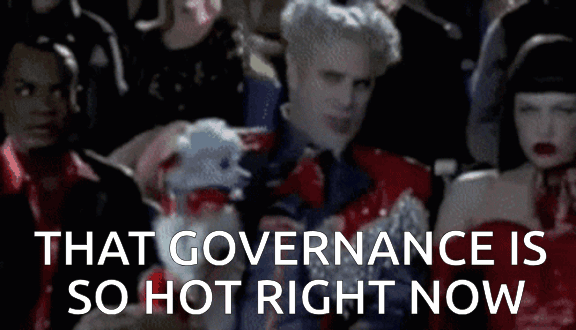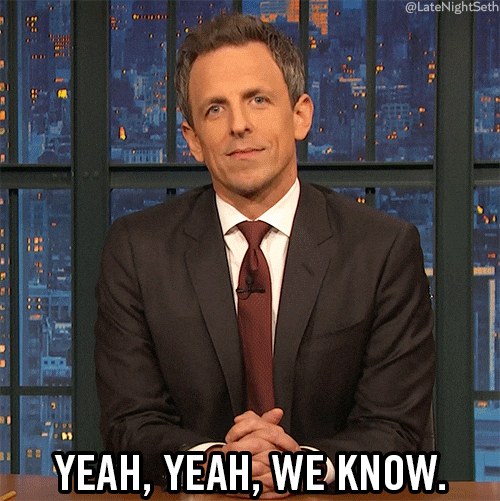
What is Governance?
We TOTALLY need Governance. What is that again?
The word of the last year (decade?) in ServiceNow and honestly IT in general is Governance. Pop around LinkedIn for a bit, you’ll see people posting about their take on it. Ask leadership? We need it yesterday. Have conversations at Knowledge or a SNUG, Governance WILL come up at some point.

This is a GOOD thing, we absolutely, 100%, no doubt in my mind need to be talking about how we govern our organization’s massive technology investments, ESPECIALLY something as large and complex as ServiceNow. Here’s the problem, what exactly is it? Myriad answers and opinions abound, and we have been on a mission to find the conclusive answer to this, scouring community articles, ServiceNow blogs, published ServiceNow docs, etc. ChatGPT does a pretty good job summing up what we found:
ServiceNow governance refers to the structured framework of policies, processes, roles, and responsibilities that ensure the effective management, alignment, and optimization of ServiceNow platform usage within an organization. It focuses on maintaining consistency, compliance, and scalability while aligning the platform’s capabilities with business objectives.
Not TERRIBLE, but it’s a little jargony, somewhat incomplete, and kind of hard to picture if you haven’t already been exposed to it. It also jams some of the Why into the definition vs. focusing on what it really is. This was the theme of what we saw — high level, leaving us with more questions than answers. Let’s try and do a little better than the machines while we still can. What we offer you here is our take on ServiceNow Governance, giving us a base understanding for further discussion (give us a follow to keep up!).

WARNING: We fully know that our view merges together aspects some folks may consider separate, e.g. Op Model. In our experience, 90% of folks aren’t at the maturity to warrant separation — we are intentionally keeping it simple for most. We also know the comparison below isn’t perfect, but it is illustrative enough for our point. Let’s take any discussion offline.
Operating Under Governance
Governance can be a dry topic so let’s try to make things a little more fun here and try to tie this to a real-world situation.
Imagine you are a passenger in a car, driving down a major street in your city on your way to the office. The idea of “getting ServiceNow Governance going” has been coming up a lot lately, and it’s made you wonder — what EXACTLY is that? Looking out the window, you realize how incredible it is that there are hundreds of vehicles, each thousands of pounds of metal, each being piloted by an incredibly diverse cast of characters, each getting where they need to go in a relatively orderly fashion relatively quickly. Parts of the road are shut down for construction or maintenance, though no one seems to notice. Sirens blare in the distance, cars are pulled over and emergency vehicles rip around helping those in need. This SHOULD be a smoldering, chaotic mess, but SOMEHOW, it isn’t. You realize that this is all possible because everyone seems to be on the same page (for the most part). You ponder for a moment — am I currently in a system under governance?
Yes, you are. Whether you notice it or not, you actively function in governed systems daily. Our road network is an excellent example of such a system. ServiceNow Governance is no different. At its best it is something you don’t consciously notice — it is simply there, enabling the smooth flow of work within the system while improvements are made to that very same system. We will dive into all the elements you need in a Governance system, but for now, let’s get back to your car ride.
Policies
“If I am in a system of Governance, what does that REALLY mean? What is enabling all this activity without chaos erupting?” You begin to think about the rules all these people are following. There are dozens, maybe hundreds, yet each seems to serve some important purpose. Other cars are all going more or less the same speed, stopping at the same places and times, avoiding the same obstacles, etc. Rules, you think. Rules must be the answer. Governance must be the set of Rules that are in place that everyone follows.
Rules or Policies are certainly an important component of Governance, but a well written set of policies does not a Governed System make. You probably already have plenty of policies for any sort of changes happening to your ServiceNow instance, yet that clearly isn’t the full story. How can it be? Does everyone even know the policies? Do you know all of them? Why are they even there? Policies are one of the more common things people think of when they think of Governance, yet the more you ponder on it, the more you realize that clearly isn’t enough. Your car ride continues.
Processes
“Hold on a sec, it’s not like everyone’s got a rule book out right now to make this whole thing work or has memorized the book. That can’t be the whole story.” You think back to when you had to get your learner’s license, it was all about rules. But reading that book and writing the test didn’t make you capable of driving. You still didn’t know HOW things actually operated. Knowing what to do at an uncontrolled intersection may have prepared you for that specific scenario in isolation — but you still needed to learn the overall PROCESS of driving that everyone else followed. Maybe that’s Governance? Policies to tell you WHAT to do and Processes that tell you HOW to do it!
Processes are the operational side of the Policy coin. The rulebook on anything is a critical governance piece, but it can really just leave someone trying to get something done confused and sitting there with an understanding of what they are NOT allowed to do. If we do NOT have a well understood, sensible, and suitable process — no one will actually know how to operate in the system. Policy and Process are two halves of the same whole, but this clearly isn’t the full story. You may have seen process flows on certain things, but none of it really made any sense to you. Also, who made that thing? And who were all the people it listed on the left-hand column? Time to get back to our ride…
People
“Well who actually made the polices and processes?” You think to yourself as you continue to look out the window. The Government? I mean yes obviously this was something that the government did — but who?. There must be SOME team of officials that has created these rules to keep things in order. And someone must be adapting these, since we certainly aren’t using the same rules from the Model T days. You also take notice that there are cops all over the place making sure we follow the rules, and they are just an extension out of that government. You also realize that everyone driving had to be licensed by the very same government. Maybe THAT’s the other part of Governance — a Government. I mean it’s right in the name. Someone designing and governing the system itself, creating and vetting these rules for all of us to follow, and giving those participating in the system their roles & responsibilities.
The People and their roles & responsibilities managing a governed system are the next important piece- and they fall into 2 categories:
-
a Governing Body, i.e. those making the rules
-
Participants, i.e. those working in the system
For the Governing body, this can be a single Governance Board, or subdivided into SteerCo’s, Management teams, Process Owners, etc. Doesn’t matter for now. The point is that these are the folks setting the policies & processes that should be dictating how ServiceNow is being worked on and what it is actually supporting. You may also have listed out the people that are participating in the processes and their various responsibilities. Problem is, we are still missing something. I’d reckon you have ALREADY got a Governance Board, Process Owners, and other roles (i.e. People) and a Policies, a RACI & Process documentation written up somewhere. And yet - Governance eludes — and the car continues to roll on.
Controls Elements (Technology)
“Hang on — there are a LOT of different things on the road that are helping people stay in order here. Those HAVE to be a piece of the puzzle.” Signs, traffic lights, the lines on the road. These aren’t just there to look pretty — they are physical manifestations of the policies & processes so that people know what they SHOULD be doing. They are reminders as much as they are a critical part of the system itself. As you have that realization you think about any other public place you’ve been to and how there was always SOME sort of a control to help keep people organized. A sign and some rope dictating a queue, or a checklist of everything you need to travel. And in that moment, it all comes together. The Policies, Processes and People don’t matter without these Control elements. People need not just reminders but actual manifestations of these rules to follow them. Nodding with a little grin, you see your destination a few blocks ahead.
This is the crucial part that seems to be the missing piece in most failed governance operations — Control Elements. For instance, in the case of ServiceNow improvement, there can’t just be a process document with certain rules written up on how new demand flows into the system, there needs to be a standard way to actually DO that. How does someone even go about suggesting an enhancement to the system? Have you made the process of submitting new enhancement requests easy to do? Is there a form someone can fill out to get the entire process rolling TODAY? Any governance documentation without clear actionable steps and instruction — preferably codified in technology itself — is going to be difficult to follow. We NEED to have the traffic lights out there telling people the state of the system and reminding them of what needs to be done.
Control Elements really are about running the processes of Governance itself — and we need SOME form of technology to capture that (though you may wanna skip the shared doc and use the premier digital workflow technology you are trying to govern). What is important is that the process is being followed, tracked, and properly actioned & communicated across the organization. With all that, we are almost at our destination!
Governance Goal
Stepping out of the vehicle at the office, you stand on the sidewalk, and you start to think. “It seems like a LOT of time and money to put into setting up all those systems, what is it all for? Was it just for my safety? Can’t be that, everyone knows the statistics on how dangerous driving is, we’d be forcing everyone to turn in their vehicles.” You look at your phone — 10 mins since you left. Not bad. Would have taken over an hour to walk… Boom. That’s when it hits you and everything comes together — ALL the work put into building this system was to allow for more safe AND fast transportation. Governance, you realize, is necessary to ensure we reach the critical balance point of optimal efficiency gain & without substantial risk. All those other things need to be in alignment with enabling this to ensure we get the best of both worlds.
This is the big thing we need to think about when the topic of Governance comes up. Done correctly, Governance is not there to just be burdensome bureaucracy, it’s there to enable you to move at pace while under control. Any ServiceNow Governance program shouldn’t exist simply to exist, it should exist to align everyone’s interests and creating the control mechanisms necessary to ensure we are getting maximum value while not blowing things up. This is a far more complex and important topic, so much so we have dedicated our entire next article to it, but this REALLY should be the point of ANY system of Governance. Their actual goals and objectives may differ (we are going to cover the ServiceNow specific ones), but the system itself is to hit that optimal balance point of control & efficiency.

Optimal being the key word...
Okay, Making More Sense Now…
Alright so let’s bring this all together here, thank you for sticking with us! We dove deep into all the different elements that make up a Governance system, and this brings us round to where we started. Let’s quickly recap and then we can get to a new definition.
There are 3 areas you MUST build out and properly align to the same goal of moving fast while under the required control to setup a proper Governance program:
-
Policies & Processes (What we can do and How we can do it)
-
People (Governing Body & Participants)
-
Control Elements (Workflows, Tasks, Communication, etc.)
This is a 3-legged stool, none are optional. In fact, even when creating this article, it became incredibly clear just how cyclical these things are. With that in mind, let’s see what we can do for our own definition here that is a little more useful.
ServiceNow Governance: The structured framework consisting of 3 key components: Policies & Processes to follow, People to create and run it (Governing Body & Enforcement/Doers), and Controls Elements (Workflows, Tasks, Communication, etc.) to make these Policies & Processes visible & actionable, all working towards the common goal of moving as fast as possible while maintaining control of the environment.
Well, that definition is a little more digestible with some more context around it. It still isn’t perfect, and much like ServiceNow, we will continue to find ways to improve it over time to at least move in that direction. This was the first step of many.

Though a big first one!
Hopefully this has made ServiceNow Governance a more approachable subject and lays the groundwork for us to take the plunge into the complexities. There is a TON more to unpack here, and this was really just an initial academic exercise to get our heads in the right space around governance itself. Now, we need to look at the important, ServiceNow focused questions such as: Who are the PEOPLE involved in ServiceNow Governance? Where does this fit into our practice? When can we start? How do we do get moving? All in good time. First, as mentioned before, we will be pulling apart the point we ended on — Why we’re doing Governance at all.
Thank you all, and we look forward to seeing you soon!
P.S. If you want to get moving TODAY and just can’t wait, please check out our ServiceNow Governance Practice Guide!